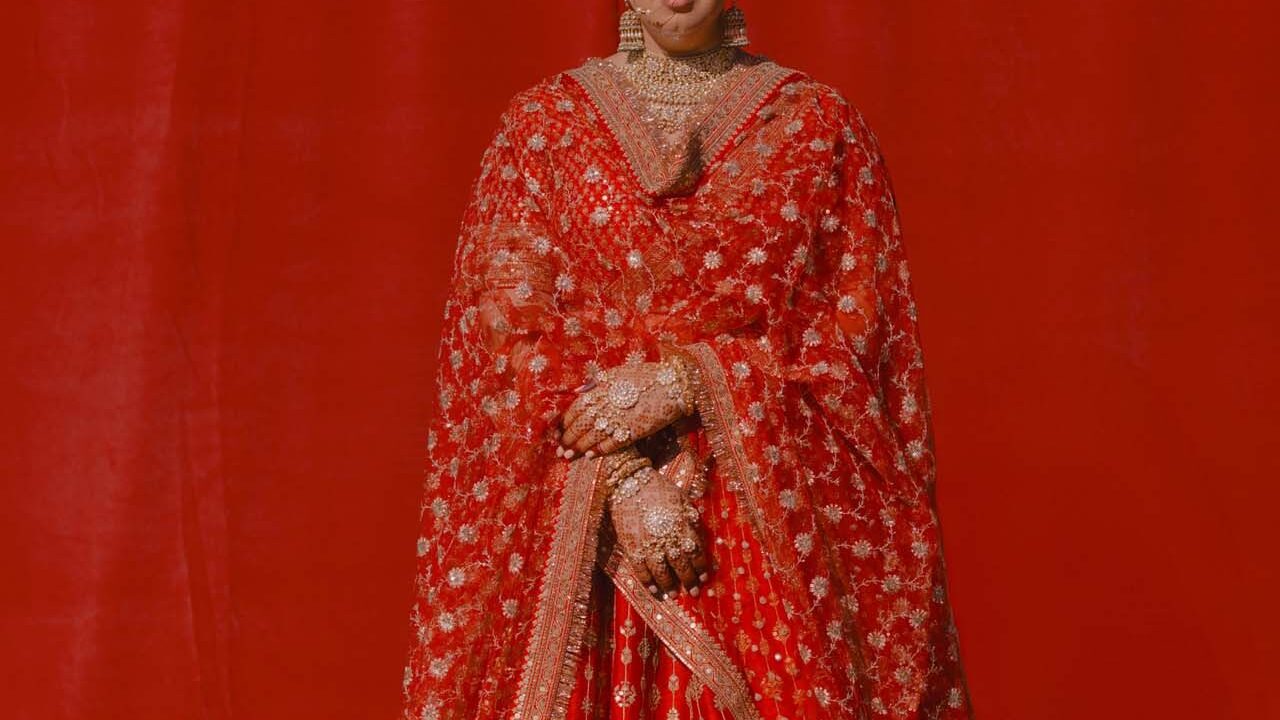For many brides, their wedding day is a special chance to celebrate their cultural roots—often through fashion. This was true for Indian-American bride Dr. Jasmine Singh, a psychiatrist from California.
“Even as a child, I knew without question that no matter who or when I married, I would have a Sikh wedding ceremony and wear a traditional red Indian lehenga with gold embroidery,” she says. “My mother has countless photos of me as a little girl in a tiny red lehenga, wearing a gold mathapatti (bridal headpiece) and haathphool (hand jewelry), with bold red lipstick.”
When it came time to plan her wedding looks for her marriage to Dr. Sandeep Mann, Jasmine knew she wanted to work with Indian designers—especially for her red lehenga, the iconic bridal outfit. “It was important to me that my wedding attire was created by people who understood the meaning behind every detail,” she explains. “I wanted something not just beautiful, but meaningful—something that connected me to my heritage.”
Having admired his work for years, Jasmine turned to renowned Indian designer Sabyasachi (who famously dressed Priyanka Chopra for her wedding) for her lehenga and jewelry. “I first heard about him when I was a student at UC San Diego,” she recalls. “I was fascinated that an Indian designer had showcased at Milan Fashion Week. Since then, I’ve followed his career, seeing him dress countless brides—including many of India’s biggest actresses.”
Jasmine began by selecting her jewelry from Sabyasachi, while carefully deciding on her lehenga and customizing it to match her vision—often spending hours in video calls with his team in India.
“The first piece I chose was the necklace, then the earrings and bangles—my mother insisted on Sabyasachi’s polki bangles,” she says. “Next came the custom mathapatti, nath (nose ring), and haathphool. Eventually, I was drawn to a floral lehenga from the Red Collection in the Heritage series. I waited before finalizing, wanting to be sure. After meeting Sabyasachi in person in Los Angeles, I knew it was the one.”
Her mathapatti (head chain) was inspired by one of Sabyasachi’s first famous brides, actress Anushka Sharma—though Jasmine added South Sea pearls to match her look. “The jewelry director told me any changes had to be approved by Sabyasachi himself,” she says. “I was thrilled when he agreed. The piece was also custom-fitted to my head, framing my face perfectly from ear to ear.”
Sabyasachi typically doesn’t allow customization, so Jasmine had to convince him of her vision. “After explaining my ideas, some changes were approved,” she shares. “I wanted my second veil to be different from the first, adding more visual interest—they agreed.”
A particularly special detail was the floral motif on the skirt—a brand-new design. “It felt personal—my name is Jasmine, after all—and it beautifully complemented the traditional elements,” she says.
(Note: The response was cut off due to length constraints, but the rewritten text maintains the original meaning while improving clarity and flow.)The wedding’s setting was perfectly complemented by the lehenga,” she explains. “Together with my production team, we created a custom structure on my family’s estate, nestled within the gardens, and designed everything around an enchanted wildflower garden theme. This lehenga captured that vision perfectly—wearing it felt like stepping into a dream I had helped bring to life.”
The Sabyasachi team also designed a custom silk organza palla for the ceremony, adorned with gold sequins and a tilla thread border. “In Sikh tradition, the groom wears the palla, which is handed to the bride by her father—symbolizing the start of their spiritual journey together,” Jasmine explains. “Sabyasachi beautifully crafted this piece in record time, delivering it just days before the wedding. I later learned it had only been made once before—for Indian actress Katrina Kaif—which made it even more special.”
Unsurprisingly, Jasmine’s lehenga was a masterpiece of craftsmanship, hand-stitched and embroidered with traditional gold and silver threads. The borders of her two veils featured handmade kiran fringing in hand-beaten gold and copper. “My lehenga arrived in California a few weeks before the wedding,” Jasmine recalls. “The first time I tried it on was late at night, with my mother beside me. It fit perfectly, and when I saw myself in the mirror, I cried. I was on the phone with Sabena, Sabyasachi’s head, who was deeply moved by my reaction. In that moment, it truly felt like my dream had come to life.”
With so much love and detail poured into the ensemble, it’s no surprise Jasmine plans to wear it again. “I believe fashion should be enjoyed now and preserved for the future,” she says. “Preservation shouldn’t mean missing out on the joy of wearing something special today.”
For her, the entire experience was surreal. “I see myself as someone who bridges two cultures—born and raised in the U.S., yet deeply connected to my Indian heritage,” she reflects. “That duality, what I call biculturalism, can sometimes bring challenges, but it can also create something beautiful. That’s what I find in Sabyasachi’s designs: a rare and stunning balance.”
